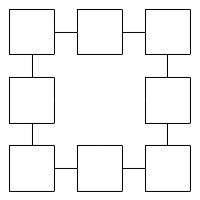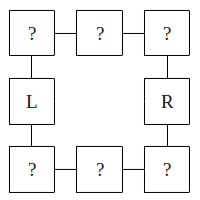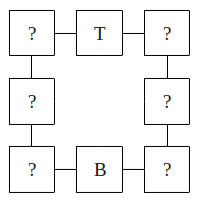My in-laws in Singapore called up, asking for a solution to this puzzle. A short while later they called again to say that they’d solved it, but only after a long period of trial and error, asking me if there was a more systematic way.
The puzzle is this : Arrange the numbers 2 to 9 in the grid below, so that the two rows and the two columns each add up to 16.

Eventually, we could guess the answer. Is there a way to avoid guessing?
The answer is, “Yes and No”. You can’t avoid guessing altogether, but with a bit of careful thought, you can drastically reduce the range of guesses than need to be checked.
Just as for the puzzle of working out the 3×3 magic square, it pays to ask what happens if we add certain rows and columns together. In this case, let’s add up the (unknown) numbers in the top and bottom rows.

Well, the puzzle says that each row and column adds up to 16, so these rows together add up to 32. Gosh, that’s easy. Let’s ask something harder : what’s left over ? What’s the sum of the cells on the left and right marked L and R ?
The puzzle says that we have to arrange the numbers 2 to 9 in the grid. 2+3+4+5+6+7+8+9 adds up to 44. The two rows add up to 32, so there’s 12 left. The cells L and R add up to 12.
There’s only a few pairs of numbers from 2 to 9 that add up to 12, namely there’s 3+9, 4+8 or 5+7. We can ignore 6+6, since we’re only supposed to use each number once. So, if we were trying to guess the values of L and R, there’s only three reasonable guesses (instead of 28 if we hadn’t thought of this trick).
The good news continues, since the same logic that tells us the sum of the column centers also tells us the sum of the row centers.

If you add up the left and right columns, that adds to 32. Adding on T and B as well has to make up the total 2+3+4+5+6+7+8+9, just as before, so T+B must be 12 as well.
So, to solve this puzzle, you don’t need to guess everything. You just need to guess which of 3+9, 4+8 or 5+7 make up the left and right cells L and R, and which of 3+9, 4+8 and 5+7 make up the top and bottom cells T and B. There’s really only three possibilities to try (since the puzzle is very symmetrical), and then guessing a single corner gives you all the rest. Make your guesses systematically, and you’ll have quickly found the one and only solution to this puzzle.
It is even quicker if you then notice that 2 and 6 must be in corners and start from there. More precisely, there is only two ways to complete a row/column with 2 on the corner, to add up to 16. I found two solutions this way, not just one.